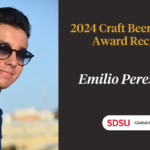
Kit-Bacon Gressitt
The SDSU Writers’ Conference has a long history of launching careers by opening doors. This annual conference was among the first to pioneer 1:1 appointments with agents and editors, giving writers unprecedented access to top-tier publishing professionals — many of whom interact with unpublished authors only through conferences.
Among the more than 300 writing enthusiasts/aspiring authors who descended upon the 2015 SDSU Writers’ Conference was Kit-Bacon Gressitt, who came in search of feedback on Ada’s Story, her thesis project in her MFA in Creative Writing program. Among her scheduled appointments was an Advance Reading with April Osborn, an assistant editor with St. Martin’s Press.
Advance Reading appointments require submitting the first 10 pages of your manuscript to be read prior to the conference. Attendees also have the option of scheduling a Consultation appointment, which is a Q&A opportunity to pitch your project as a whole and discuss its viability in the marketplace.
Every year, each editor and agent chooses their favorite project(s) for a Conference Choice Award, and Gressitt’s was chosen by Osborn. We trace Gressitt’s SDSU Writers’ Conference experience, and where she is today on her journey to publication.
Are you a writer by profession or is it an avocation?
I’ve been a writer by profession, although I’m new to book-length creative writing.
Tell us about the project that brought you to the 2015 SDSU Writers’ Conference.
I was in the UC Riverside low-residency MFA in Creative Writing program, and I wanted some independent eyes on my narrative nonfiction thesis project, a story about peeling away family and national myths to find some semblance of truth underneath. As relationships between advisors and MFA candidates develop, I think there’s a tendency to be more encouraging than critical, but I wanted the opposite, and I hoped the advance readings at the SDSU Writers’ Conference would provide a reality check, confirmation that my story might have appeal to a broader audience — or not.
How long have you been working on it?
I started Ada’s Story the second term into the seven-term MFA program, with the goal of completing the manuscript prior to graduation, which I did — by abandoning family and friends to do nothing but writing and researching for two years. They were very accommodating, pushing food into my office now and then.
Care to share the opening lines?
Dust and ash swirled around Ada Latta as she strained from her saddle to tie the remnant sleeves of Father’s nightshirt to the stake. She gave it one more pound with his mallet. The sleeves coiled back to their knot at the shock, then reached for the expanse of her one-hundred-sixty-acre claim and clapped in the hot wind. Even the bluestem grass applauded, stalks slapping stalks with each gust.
Could you tell that April was pretty excited about your 10 pages or was it a complete surprise when you heard your name announced as a Conference Choice winner?
My reader, April Osborn, with St. Martin’s Press, was clear and direct about her interest in the manuscript, which was then incomplete, but I was surprised about the Conference Choice award, primarily because I failed to read the entire SDSU conference website — didn’t notice there were awards — so that was a nice stroke.
Are you still heady with euphoria?
I’m not prone to euphoria. Maybe I’ve lived too long, although President Obama’s Amazing Grace rendition and Bree Newsome’s removal of the Confederate flag from the Charleston, SC statehouse were pleasing.
Did April give you any suggestions on reworking the first 10 pages?
She suggested eliminating the author’s note that some of my professors had recommended, given the unusual structure of the manuscript, so it was nice to hear from her that the structure was clear without an author’s “Yo, reader, heads-up!”
How did you hear about the SDSU Writers’ Conference? Was 2015 your first time or have you attended before?
I’d heard about the SDSU Writers’ Conference through various local writerly outlets and colleagues, but the 2015 conference was the first I attended — and I’m glad I did. The editor’s feedback was both pragmatic and enthusiastic.
What do you think is one of the greatest strengths of the conference?
The SDSU Writers’ Conference is one of the better organized conferences I’ve attended, and the 2015 event had a strong agent and editor presence.
Did you make a connection with a fellow writer or an editor or agent at one of the mixers or the networking lunch?
I chatted with a lot of writers, which is always fun. It’s a treat to crawl out of one’s writing hole and find similarly obsessive folks at literary events — an infrequent opportunity to feel socially acceptable.
What’s the first book that spoke to you as a young reader?
The Moomin books by Tove Jansson and Mistress Masham’s Repose by T.H. White represent my earliest reading that I recall — nice blends of fantasy, ominous adversary, and youthful triumph.
Who’s your favorite author (or top three if it’s hard to choose one)?
Today, my favorite authors are Joyce Carol Oates, Laura Esquivel, and Carson McCullers.
What keeps you going in the pursuit of your writing goal?
What keeps me writing? I can’t think of anything that would stop me.
What’s the status of your manuscript today?
With the help of a writerly friend, I obtained representation at Trident Media. My agent, Amanda O’Connor, requested some revisions. So, since the summer, I’ve been teaching at Cal State San Marcos part-time and revising like crazy, which I love — fun, fun, fun! I’m on track to finish revisions by January, and then it’ll go back to April and to some other editors. I’m also attending the SDSU Writers’ Conference again in January to pitch it.
All of which brings me to another benefit of the conference. At the end of my MFA program, I had a manuscript I probably could have sold to a university press — and I’d have been delighted with that. However, the SDSU Writers’ Conference provides access to publishing professionals who are keenly aware of what’s selling, and this knowledge is a big plus. The input of these editors and agents has boosted the potential for my work to reach a broader audience, the prospect of which delights me even more.




